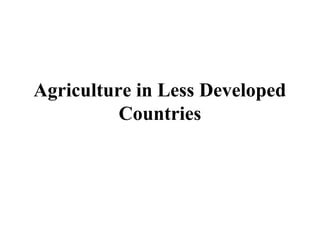
LDC Agriculture
- 1. Agriculture in Less Developed Countries
- 2. LDC Agriculture • Five types of agriculture typify the less developed country – Shifting cultivation – Pastoral nomadism – Intensive subsistence wet rice dominant – Intensive subsistence non wet rice dominant – Plantation farming
- 4. Shifting Cultivation Slash and burn or swidden agriculture Extensive subsistence Slash and burn- vegetation is removed and burned, releasing nutrients that fertilize Land is cleared, followed by two or three years of cultivation until abandoned because of declining soil fertility and weeds Land is left fallow for up to 20 years Today, practiced in tropical regions (low latitudes) intertillage, human labor, crop rotation, staggered sowing Low population densities; as populations grow…
- 6. Shifting Cultivation Intertillage
- 7. Shifting Cultivation Slash and Burn Agriculture
- 8. Shifting Cultivation South America Maize Manioc (cassava) Africa Millet Sorghum yams sugarcane plantains
- 9. Cassava
- 10. Plantains
- 11. Maize
- 12. Pastoral Nomadism Sedentary or nomadic, small plots of crops may be planted and tended by women and children Extensive subsistence Practiced in arid or mountainous regions that lack of fertile soil, deserts, steppes, savannahs Reliance on animals Mobile and small populations Sheep, cattle, goats, camels, yaks, horses, reindeer transhumance: movement between cooler mountains (summer) and warmer lowlands (winter)
- 13. Pastoral Nomadism Kyrgyz yurt made of felt; known as a ger by the Mongolians
- 14. Intensive Subsistence densely populated rural areas small, fragmented plots work done by hand or animals no land is wasted (terracing) crops for human consumption
- 16. Intensive Subsistence Wet Rice refers to planting rice initially on dry land in a nursery and then moving seedlings to a flooded field occupies a small % of Asia’s land but is region’s most important source of food Southeast China, East India and Southeast Asia All family members contribute to the work load Buffalo or oxen Found near river valleys and deltas Terraced hillsides, some use of irrigation Double cropping = two crops a year per field Common in areas with warm winters Wet rice grown in summer and another crop (barley or wheat) grown in dry winter season
- 17. Intensive Subsistence Wet Rice
- 18. Intensive Subsistence Wet Rice
- 19. Intensive Subsistence non-Wet Rice Parts of Asia where summer precip levels are too low and Pearl winter months are too cool Millet, grown in Interior India and northeast Africa China Wheat is most important crop followed by barley Millet, oats, corn, sorghum, soybeans also grown for individual consumption Millet is a type of grain grown in dry and cool climates where wheat or barley can’t; can be stored for five years
- 20. Millet •Millet is a collective term for a variety of grasses that produce small, rounded seeds that are harvested for food •in developing nations, millet is used for food, animal bedding, construction materials, and forage fodder for animals •hardy annual capable of growing in conditions that would kill other crops •thrives in intense heat and poor soil, which makes it a natural choice for areas of the world that are turning into deserts •high concentrations of numerous vitamins, as well as a high volume of protein—a little over one tenth of the grain is protein •millet is gluten free •grows quickly and can be harvested as soon as three months after planting, providing an opportunity to get two or even three crops in a year
- 21. Millet
- 23. Sorghum •used for food (as grain and in sorghum syrup or "sorghum molasses"), fodder, and the production of alcoholic beverages •Most species are drought tolerant and heat tolerant and are especially important in arid regions •cereals that thrive in semi-arid regions and provide important human food in tropical Africa, central and north India, and China •Sorghum produced in the USA and Australia is used for animal feed
- 24. Sorghum
- 25. Rice
- 27. Intensive Subsistence non-Wet Rice Cash crops may be grown in this region: cotton, flax, hemp, tobacco Crop rotation will allow some use of double cropping Different varieties of sorghum can be grown for feed or for making Flax flower and seeds molasses
- 28. Cotton
- 29. Plantation A form of commercial agriculture Crops grown in LDC’s but fields and plantations are owned by MDC’s and sold in MDC’s Latin America: coffee, sugarcane, bananas Asia: rubber, palm oil Work spread evenly throughout the year; some double cropping
- 30. Plantation Crops: tea lumber coffee banana rubber cacao tobacco sugarcane cotton pineapple
- 31. Plantation Breadfruit Native to East Indian ocean and Western Pacific Islands
- 33. Plantation Cacao •Introduced to the South American region by the Mayas of the Yucatan •Used for chocolate and cocoa •Beans once used as Cacao tree with fruit pods currency •Currently practiced in tropical environments
- 34. Plantation Rubber •Native to Central and South America •Now practiced primarily in Asia Rubber tree
- 35. Plantation Sugarcane •Caribbean region •Tropics and subtropics •Industry expected to crash by 2009 •In Brazil, can be used in production of fuels Sugarcane
- 36. Plantation Pineapple •Native to Brazil, Bolivia and Paraguay •Symbol of hospitality •Major producers: Thailand, Philippines, Brazil •Scales arranged in spirals of eight and Pineapple field, Hawaii thirteen, an example of a Fibonacci symbol existing in nature